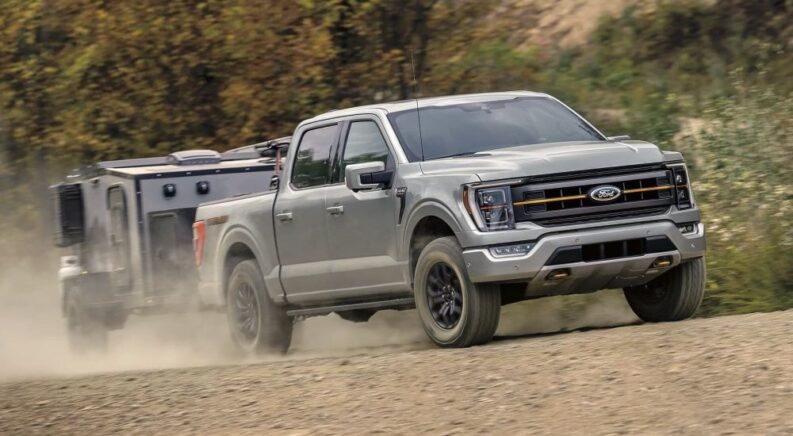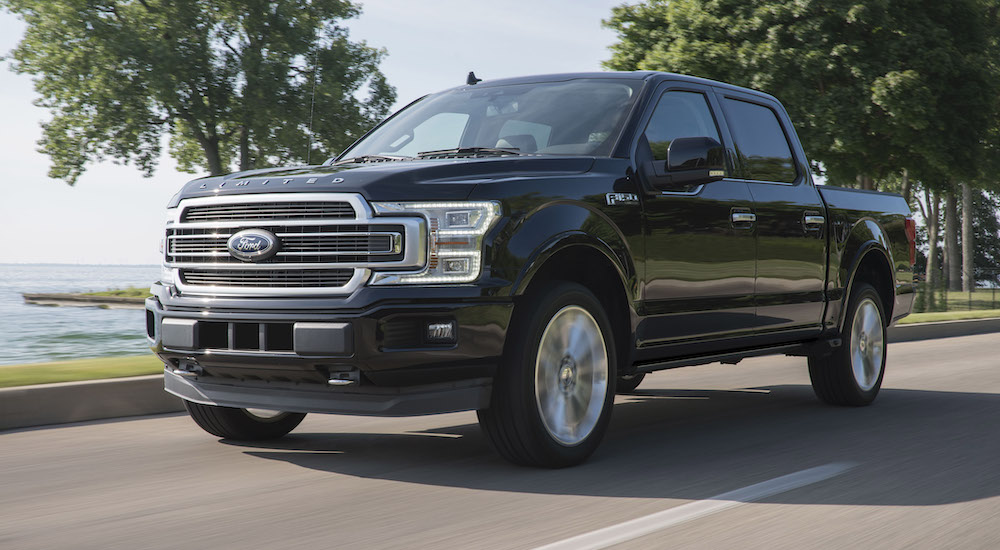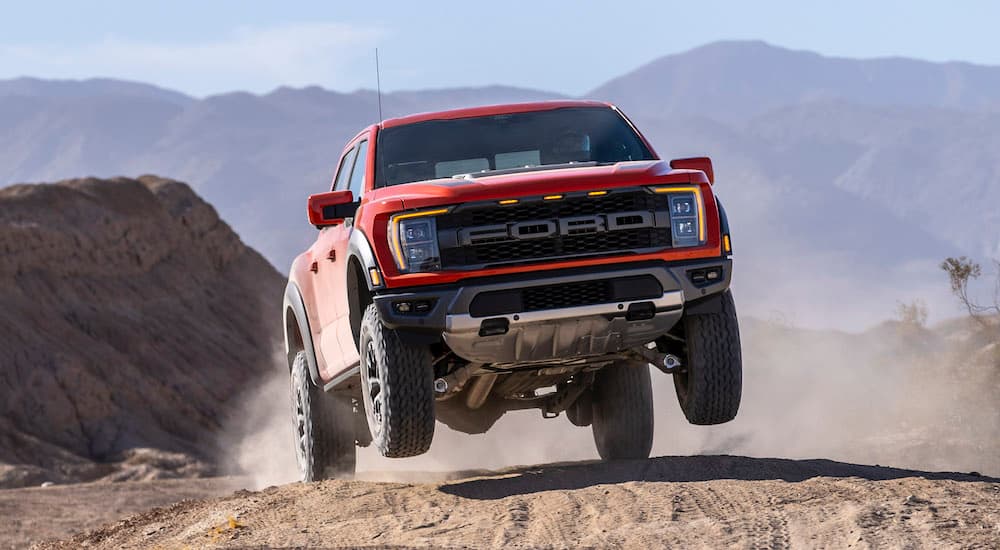No matter how you look at it, the F-150 is undoubtedly one of the auto industry’s biggest success stories. Ford has sold more than 40 million F-150s since the nameplate was first introduced, which makes the popular pickup not only the best-selling truck in America but the best-selling vehicle of any kind. The Big Blue Oval moved over 640,000 F-150s in 2022 alone, which, if they were lined up end-to-end, would stretch from Ford’s Detroit headquarters all the way to the Pacific Ocean. These numbers speak to the focus on reliability and performance that’s long been at the heart of the F-150 brand. Still, even when you factor in the pickup’s stellar reputation, it’s hard to explain its unwavering dominance. So, how has the F-150 managed to stay ahead of the competition for almost five decades? It all comes to a spirit of innovation that has seen the F-150 continually reinvented to keep up with the times, with Ford pushing the envelope and testing the limits of the pickup segment. Before you shop around for a used Ford F-150 for sale, take a few minutes to learn about the automaker’s never-ending quest to build a better pickup.
A Strong Start
Innovation has been a key part of Ford’s success since the brand’s earliest days. Henry Ford might not have invented the idea of the automobile or the assembly line, but he did perfect them. By making subtle tweaks and practical decisions that allowed both technologies to flourish, Ford ushered in the era of personal gas-powered transportation. This reputation as an automotive visionary extends to the pickup segment where, in 1925, Ford introduced the first factory-built pickup with a steel cargo bed in the Model T Runabout.
Before this move, cargo beds were typically installed by third-party firms. By making the feature a factory-installed option, Ford could better meet the needs of the brand’s customer base while eliminating the time, cost, and hassle of sourcing an aftermarket bed. It’s one of the earliest examples of Ford’s ability to predict coming automotive trends, earning the brand plenty of success in the years to come.
World War II saw Ford shift its focus to producing bombers and Jeeps. The return to peacetime saw the introduction of the F-150 forerunner in the first F-Series pickup, dubbed the Ford F-1. Marketed with a focus on towing capacity, cab comfort, and the spacious bed, the F-1’s selling points are surprisingly similar to those splashed across the promotional material for any modern pickup. It’s an impressive example of foresight from Ford and a sign that, regardless of the era, some things never change.
Injecting Innovation
While F-Series trucks have been available in one form or another since 1948, the first true F-150 wouldn’t hit the market until 1975. Like previous F-Series offerings, the F-150 was built on Ford’s fourth-generation platform with some important upgrades in front disc brakes, double-wall bed construction, improved cabin dimensions, and an increased reliance on galvanized steel. These changes made the F-Series pickups more rough-and-tumble than ever, increasing the lineup’s profile as a hard-working truck built to get the job done. As the Ford F-Series moved into its seventh generation, the F-150 truly came into its own with Ford introducing an all-new chassis. The new design not only modernized the look of the F-150, but it also gave the pickup a more aerodynamic profile—and, therefore, better fuel economy—which was an essential consideration in the 1980s following the oil crisis.
The F-150 would continue to add to its long list of firsts in 1987 when the eighth-generation model debuted in 1987. What made the eighth generation so special? It all comes down to the truck’s optional 5.0-liter V8 engine that made the F-Series the first American pickup truck model line to be sold without carbureted engines. Ford took a chance on the relatively unproven fuel injection technology, which paid off in a big way. Like the redesigned chassis from the F-150’s seventh generation, the main advantage of fuel injection comes down to efficiency. Fuel injectors allow gas to be more precisely fed into the engine, which helps to reduce fuel consumption and emissions. The technology started to make its way into many vehicles throughout the 1970s, but Ford was the first to bring the innovation to the pickup segment. The switch allowed pickups to become a more well-rounded option for drivers of all stripes, mixing power, performance, utility, and efficiency in a way that continued to drive sales for years to come.
Building A Better Pickup
The F-150 has never been one to rest on its laurels, with new and exciting innovations debuting with every generation. While the F-150 has gone through far too many changes to catalog in one article, there are a few more highlights to mention as we trace the evolution of the country’s favorite truck. When the 10th-generation F-150 hit the streets in 1997, it was the overhead camshaft engine that earned a nod as the pickup’s most progressive feature. Originally debuting in the Ford Crown Victoria and Grand Marquis, the F-150’s overhead camshaft engine was the first to be installed in a full-size pickup. The overhead camshaft design boasts several advantages over previous concepts, allowing for better engine performance, higher RPMs, and a more lightweight engine all around.
The F-150 would get another ‘first’ in 2015 when it became the first pickup to be offered with adaptive cruise control. The feature allowed drivers to set a desired speed and following distance to the vehicle ahead, with the cruise control system making constant adjustments to keep the truck at the correct speed. The addition of adaptive cruise control speaks to the changing customer base for the truck market, characterized by a new breed of driver who values comfort and convenience just as much as power and utility. Growing up on a steady diet of SUVs and crossovers, these drivers are now seeking something a little more accessible. Ford was one of the first automakers to recognize the trend, introducing “creature features” like adaptive cruise control to make for a more comfortable, accessible driving experience aimed towards such drivers.
When discussing the success of Ford’s F-150 pickup, you can’t ignore the importance of customization. If the F-150 were a single model with a short list of options, it probably never would have made such inroads with such a broad swathe of drivers. The same foresight that led Ford to introduce features like adaptive cruise control and fuel injection has also informed the F-150’s long trims list, allowing drivers to build a pickup that meets their unique needs and specifications. The F-150 is unique in the auto market in that it’s almost an entire automotive brand within itself. You’ll find affordable entry-level pickups, specialty trims aimed at maximizing off-road fun, and luxury models miles away from the bare-bone, workhorse pickups of old.
An extensive trim ladder also puts the F-150 within financial reach for many drivers. Looking for a new pickup on a budget? The entry-level XL trim is a bargain with a starting price of just $37,000. Moving up to the XLT provides significant upgrades like sport alloy wheels, the Ford SYNC 3 infotainment system, and a Wi-Fi hotspot. The $60,000 Lariat trim could be a sweet spot for many drivers, combining the F-150’s reputation for power and performance with a generous slate of comfort and convenience features that make the pickup into a home away from home. If you’re looking for a no-holds-barred luxury vehicle that just happens to be a hard-working pickup, the range-topping Platinum ($68,000) and Platinum Plus ($86,000) are worth a closer look. Ford has recently expanded its F-150 offerings to include thrilling off-road-ready models like the Tremor ($65,000) and F-150 Raptor ($77,980). However, the latter is usually treated as its own separate model.
Ford shows no signs of slowing down when it comes to F-150 innovation. The all-electric F-150 Lightning represents the most notable addition to the lineup, leveraging all the benefits of the EV approach to create one of the most cutting-edge, powerful pickups to ever wear the F-150 badge with its 131 kWh dual motor, offering 580 hp, 775 lb-ft of torque and a zero-to-60-mph time of 4.0 seconds to its name. The F-150 Lightning might not have been the first all-electric pickup to hit the road. Still, it was the first such offering from an established brand such as Ford, which carries many advantages when it comes to both reliability and consumer confidence. Diving headfirst into the EV pickup segment was a bold decision on Ford’s part. Still, those bold decisions and forward-thinking moves have kept the F-150 far ahead of the competition year after year. The gamble already looks to be paying off as rival brands struggle to play catch-up, and demand has been off the charts, with Ford recently retooling some production facilities to triple F-150 Lightning production. The success of the F-150 has allowed Ford to take these types of chances, pushing the envelope to usher in the next generation of pickup innovation and allowing drivers to enjoy the results. With that sort of track record, it’s hard to see the Ford F-150 losing the full-size pickup crown at any point soon.






